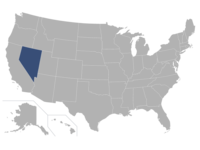Legislative conservation agenda includes wildlife crossings, EV trucks, and septic tanks

Historic drought and declining reservoirs have dominated the conversation around Nevada’s environmental woes, but state legislators are looking at “common sense” conservation efforts that can be implemented at the state level during the upcoming legislative session.
Protecting Nevada’s wildlife is on the list of priorities for legislators and conservation groups pushing bills to restore the state’s natural resources.
Democratic Assemblyman Howard Watts, chair of the Committee on Growth and Infrastructure, is leading legislation to fund wildlife crossings — artificial passages that help animals safely cross busy roads and connect fragmented habitats.
Every year, collisions between motorists and wildlife cause over 200 human fatalities and more than 26,000 injuries, according to the U.S. Department of Transportation. Slow moving wildlife like the threatened Mojave desert tortoise, is especially at risk.
Each year, about 500 reported wildlife-vehicle collisions kill more than 5,000 animals — costing the state nearly $20 million a year — say state transportation officials. The Nevada Department of Transportation estimates the actual number is likely significantly higher.
The bill, AB112, would establish an account with seed funding in the state general fund to construct, restore, and protect wildlife crossings in Nevada. The account would house state dollars to leverage federal funds currently available under the Infrastructure Investment and Jobs Act President Biden signed last year.
The federal infrastructure law established a wildlife-crossing safety program to help fund projects that reduce wildlife-vehicle collisions and improve habitat connectivity. The law provides $350 million in competitive grants over five years to states, communities, and tribes. Nearly $60 million in grant funding was authorized in fiscal year 2022.
Competitive grant programs require matching state funds, but under very attractive terms for the state, Nevada could benefit from 90% matching funds, said Watts, meaning a $10 million state investment could leverage an additional $90 million in federal funding.
Those funds could “accelerate projects that we may have been waiting 10 or more years to construct,” said Watts during an event organized by the Nevada Conservation League Tuesday.
Recently, state legislatures in California, Colorado, New Mexico, Oregon, Utah, and Wyoming passed laws to reduce the impacts of habitat fragmentation and fund the construction of new wildlife-friendly bridges and underpasses.
“Nevada has been a leader in taking on this issue and we’ve already constructed some excellent wildlife crossings that have helped reduce collisions and improve safety on our roadways,” Watts said.
Completed in 2010, the Highway 93 overpass near Elko — the state’s first wildlife crossing — provided passage for more than 35,000 mule deer in its first four years.
The Nevada Conservation League said the bill’s passage is one of its top priorities during the 2023 Nevada Legislative Session.
Wastewater
During the Tuesday event, Watts said the Committee on Natural Resources will push draft legislation to address water conservation and enhance the return of water flow in southern Nevada.
One draft bill focused on water conservation recommended by the Southern Nevada Water Authority has to do with wastewater.
The water agency suggested that to reach water conservation goals, Nevada needed legislative action to ensure that Colorado River water is not used for new septic systems in southern Nevada.
In Southern Nevada, wastewater captured from homes and businesses attached to the municipal sewer system is sent to a treatment facility where it is treated and returned to the Colorado River. Every gallon of water returned to the river allows Southern Nevada to take another gallon out.
Still, there are more than 14,000 homes in Southern Nevada on a septic system, which uses significantly more water than those connected to a municipal water system. Water captured by septic tanks can’t be routed to a treatment plant where it could be treated and be used again, according to SNWA.
Water managers warn Southern Nevada will have to adjust its current 110 gallons per capita per day usage to 86 gallons by 2035 to maintain sustainable water resources, and every drop counts.
Electrification
During the Tuesday event covering the Nevada Conservation League’s legislative priorities, the advocacy group said they also plan to push for financial incentives for medium and heavy duty electric vehicles.
Although medium and heavy-duty vehicles make up only 5% of vehicles on the road, they’re responsible for 30% of carbon pollution from the transportation sector, said Christi Cabrera-Georgeson, the deputy director of the Nevada Conservation League.
Watts proposed legislation that could leverage federal funding to create a state incentive program for medium and heavy-duty electric vehicles, including the electrification of school and transit buses.
Funding for the bill would come from the Inflation Reduction Act which contains tax credits that boost adoption of medium- and heavy-duty electric vehicles. The law allocates $1 billion to states, municipalities, tribes, or non-profit schools to replace heavy-duty vehicles with electric vehicles.
“The goal of this legislation is going to be to use some of that funding to set up a program that will provide a state level incentive to public or private entities that want to obtain these vehicles,” Watts said.








